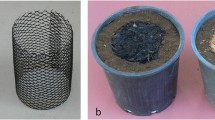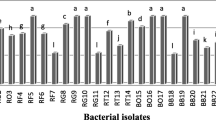Abstract
Soil was collected from a sugarcane field where most of the second-stage juveniles of root-knot nematode (Meloidogyne javanica) were encumbered with endospores of Pasteuria penetrans. A pot experiment was established to determine whether the bacterium was present at levels capable of reducing populations of the nematode. Endospores of the bacterium were eliminated by autoclaving the soil and then eggs of Meloidogyne javanica were inoculated into Pasteuria-free and naturally-infested soil. When the experiment was harvested 19 and 37 weeks later, the root-knot nematode population was respectively 96 and 99% lower in the naturally-infested field soil, indicating that this soil was highly suppressive to the nematode. Pasteuria penetrans was also mass-produced on its nematode host and a further experiment was set up to determine the effect of endospore concentration in soil on multiplication of root-knot nematode. Sugarcane was grown in pasteurised sand containing 0, 6000, 12,000, 24,000 and 50,000 endospores/g soil and treatment effects were assessed after 6, 13 and 20 months. The results showed that regardless of harvest time, the severity of root galling and the number of nematode eggs produced per plant decreased as the endospore concentration increased. The lowest endospore concentration significantly reduced the number of eggs per plant at all three harvest times while the highest concentration reduced egg numbers by 96, 88 and 81% at 6, 13 and 20 months, respectively. These results suggest that when high endospore concentrations are continually maintained in the root zone, P. penetrans will markedly reduce populations of root-knot nematode, a particularly important pest of sugarcane.

Similar content being viewed by others
References
Birchfield W (1984) Nematode parasites of sugarcane. In: Nickle WR (ed) Plant and insect nematodes. Marcel Dekker Inc, New York, pp 571–588
Bird AF, Brisbane PG (1988) The influence of Pasteuria penetrans in field soils on the reproduction of root-knot nematodes. Rev Nématol 11:75–81
Blair BL, Stirling GR (2007) The role of plant-parasitic nematodes in reducing the yield of sugarcane in fine-textured soils in Queensland, Australia. Aust J Exp Agric 47(5):620–634. https://doi.org/10.1071/EA05287
Blair B, Stirling GR, Whittle P (1999a) Distribution of pest nematodes on sugarcane in south Queensland and relationship to soil texture, cultivar, crop age and region. Aust J Exp Agric 39(1):43–49. https://doi.org/10.1071/ea98085
Blair BL, Stirling GR, Pattemore JA, Whittle PJL (1999b) Occurrence of pest nematodes in Burdekin and central Queensland canefields. Proc Aust Soc Sugarcane Technol 21:1–7
Bridge J (1986) Plant nematode survey of Ramu sugar limited, Ramu Valley, Papua New Guinea. Report, CAB International, Institute of Parasitology, St. Albans
Bull RM (1979) New chemicals for nematode control in the Bundaberg district. Proc Aust Soc Sugarcane Technol 1:99–103
Bull RM (1981) Studies and observations on nematode control in the Bundaberg district. Proc Aust Soc Sugarcane Technol 3:267–274
Cadet P, Spaull VW (2005) Nematode parasites of sugarcane. In: Luc M, Sikora RA, Bridge J (eds) Plant parasitic nematodes in subtropical and tropical agriculture. CAB, Wallingford, p 645–674
Chandler KJ (1978) Non-volatile nematicides: an initial assessment in North Queensland sugar cane fields. Proc Aust Soc Sugarcane Technol 45:85–91
Chandler KJ (1980) Continued experiments with non-volatile nematicides: an initial assessment in North Queensland sugar cane fields. Proc Aust Soc Sugarcane Technol 2:75–82
Chen ZX, Dickson DW (1998) Review of Pasteuria penetrans: biology, ecology and biological control potential. J Nematol 30(3):313–340
Chen S, Dickson DW, Whitty EB (1994) Response of Meloidogyne spp. to Pasteuria penetrans, fungi, and cultural practices in tobacco. J Nematol 26(4 Suppl):620–625
Chen ZX, Dickson DW, McSorley R, Mitchell DJ, Hewlett TE (1996) Suppression of Meloidogyne arenaria race 1 by soil application of endospores of Pasteuria penetrans. J Nematol 28(2):159–168
Davies KG, Kerry BR, Flynn CA (1988) Observations on the pathogenicity of Pasteuria penetrans, a parasite of root-knot nematodes. Ann Appl Biol 112(3):491–501. https://doi.org/10.1111/j.1744-7348.1988.tb02086.x
Dickson DW (1998) Peanut. In: Barker KR, Pederson GA, Windham GL (eds) Plant and nematode interactions. Agronomy monographs no. 36. American Society of Agronomy Inc, Madison, pp 523–566
Kenward MG, Roger JH (1997) Small sample inference for fixed effects from restricted maximum likelihood. Biometrics 53(3):983–997. https://doi.org/10.2307/2533558
Saxton AM (1998) A macro for converting mean separation output to letter groupings in Proc mixed. In: Proc 23rd SAS users group Intl., SAS Institute, Cary, pp 1243–1246
Spaull VW (1981) Bacillus penetrans in south African plant-parasitic nematodes. Nematologica 27(2):244–245. https://doi.org/10.1163/187529281X00322
Spaull VW (1984) Observations on Bacillus penetrans infecting Meloidogyne in sugar cane fields in South Africa. Rev Nématol 7:277–282
Stirling GR (1981) Effect of temperature on infection of Meloidogyne javanica by Bacillus penetrans. Nematologica 27(4):458–462. https://doi.org/10.1163/187529281X00458
Stirling GR (1984) Biological control of Meloidogyne javanica with Bacillus penetrans. Phytopathology 74(1):55–60. https://doi.org/10.1094/Phyto-74-55
Stirling GR (2006) Susceptibility of sugarcane varieties to two species of root-knot nematode (Meloidogyne javanica and M. incognita), and implications for crops grown in rotation with sugarcane. Proc Aust Soc Sugarcane Technol 28:345–350
Stirling GR (2008) The impact of farming systems on soil biology and soilborne diseases: examples from the Australian sugar and vegetable industries – the case for better integration of sugarcane and vegetable production and implications for future research. Australas Plant Pathol 37(1):1–18. https://doi.org/10.1071/AP07084
Stirling GR (2009) An improved farming system enhances suppression of root-knot nematode, but what organisms are responsible? Handbook, Fifth Australasian Soilborne Diseases Symposium, Thredbo, 80–82
Stirling GR (2014) Biological control of plant parasitic nematodes. 2nd edition. Soil Ecosystem Management in Sustainable Agriculture. CAB International, Wallingford
Stirling GR, Wachtel MF (1980) Mass production of Bacillus penetrans for the biological control of root-knot nematodes. Nematologica 26(3):308–312. https://doi.org/10.1163/187529280X00260
Stirling GR, White AM (1982) Distribution of a parasite of root-knot nematodes in south Australian vineyards. Plant Dis 66(1):52–53. https://doi.org/10.1094/PD-66-52
Stirling GR, Sharma RD, Perry J (1990) Attachment of Pasteuria penetrans spores to Meloidogyne javanica and its effects on infectivity. Nematologica 36(1):246–252. https://doi.org/10.1163/002925990X00211
Stirling GR, Blair BL, Pattemore JA, Garside AL, Bell MJ (2001) Changes in nematode populations following fallow, fumigation and crop rotation, and implications for the role of nematodes in yield decline. Australas Plant Pathol 30(4):323–335. https://doi.org/10.1071/AP01044
Stirling GR, Hayden HL, Pattison AB, Stirling AM (2016) Soil biology, soilborne diseases and sustainable agriculture. A guide. CSIRO Publishing, Melbourne
Stirling GR, Wong E, Bhuiyan S (2017) Pasteuria, a bacterial parasite of plant-parasitic nematodes: its occurrence in Australian sugarcane soils and its role as a biological control agent in naturally-infested soil. Australas Plant Pathol 46(6):563–569. https://doi.org/10.1007/s13313-017-0522-z
Vagelas I, Pembroke B, Gowen SR (2011) Techniques for image analysis of movement of juveniles of root-knot nematodes encumbered with Pasteuria penetrans spores. Biocontrol Sci Tech 21(2):239–250. https://doi.org/10.1080/09583157.2010.535895
Weibelzahl-Fulton E, Dickson DW, Whitty EB (1996) Suppression of Meloidogyne incognita and M. javanica by Pasteuria penetrans in field soil. J Nematol 28(1):43–49
Whitehead AG, Hemming JR (1965) A comparison of some quantitative methods of extracting small vermiform nematodes from soil. Ann Appl Biol 55(1):25–38. https://doi.org/10.1111/j.1744-7348.1965.tb07864.x
Williams JR (1960) Studies on the nematode soil fauna of sugarcane fields in Mauritius. 5. Notes upon a parasite of root-knot nematodes. Nematologica 5(1):37–42. https://doi.org/10.1163/187529260X00235
Acknowledgements
Sugar Research Australia provided financial support for this work through project 2014/004.
Author information
Authors and Affiliations
Corresponding author
Rights and permissions
About this article
Cite this article
Bhuiyan, S.A., Garlick, K., Anderson, J.M. et al. Biological control of root-knot nematode on sugarcane in soil naturally or artificially infested with Pasteuria penetrans . Australasian Plant Pathol. 47, 45–52 (2018). https://doi.org/10.1007/s13313-017-0530-z
Received:
Accepted:
Published:
Issue Date:
DOI: https://doi.org/10.1007/s13313-017-0530-z




